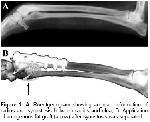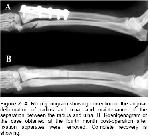A well coordinated, synchronous growth of the radius and ulna is needed for the normal development of the distal foreleg in the dog. If the alteration in the growth patterns occurs early in development, the resulting changes are proportionately worse
1. Deformities of the distal foreleg of the dog can be attributed to a variety of etiologies. Trauma, hypertrophic osteodystrophy, nutritional secondary hyperparathyroidism, retarded enchondral ossification of the ulna and genetic causes have been reported
2. The incidence of premature closure or fusion resulting in growth deformities is greatest in the distal ulnar growth plate of dogs
1. Because of its conical shape, the distal ulnar physis commonly undergoes compression when traumatized
3,4. As the radius continues to grow, it bows away from the ulna. The humeroulnar joint undergoes subluxation, resulting in carpal valgus and external rotation of the paw
1,5. Application of splint, staple bridging the growth plate, tension band wire, and corrective osteotomies were treatment methods of distal ulnar physeal closure in dogs
5-7. The simplest techniques is a segmental ulnar ostectomy, which can easily be performed through a caudal approach to the ulna
8. If bone growth has ceased, definitive correction of ulnar physeal closure is indicated. A predetermined size wedge of bone is removed from the point of maximal deformity
4.
Synostosis is described as common consolidation between the radius-ulna, tibia-fibula, two neighboring ribs, metacarpal and metatarsal bones after fracture9-14. An abnormal union between the radius and ulna may occur, restricting the synchronous growth of the radius and ulna1. This restriction is synchronous growth causes supination and pronation in cats and dogs3. Bridging callus can be resected, and the defect is filled with an autogenous fat graft to prevent reformation in treatment of synostosis15-17.
In this report, the use of autogenous fat tissue and operation technique for a case of synostosis existing with a growth deformity in radius-ulna in a dog was described.




